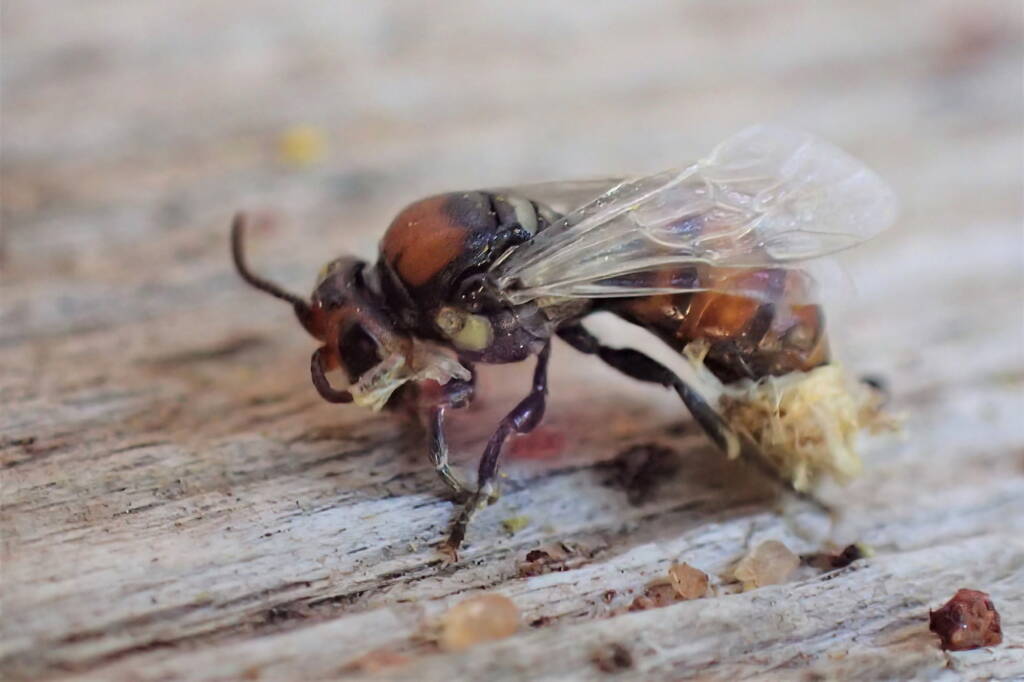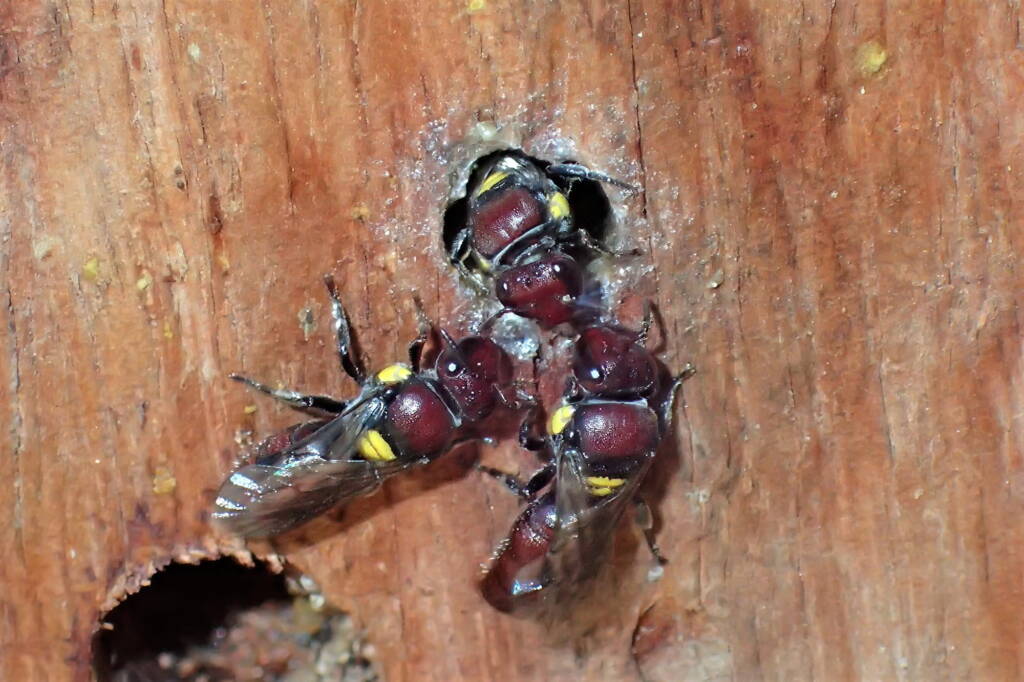Author Gary Taylor ◦ Contribution Ken Walker
Ok, so here’s an oddity… I went to check on my bees…
1st pic, just to set the scene, one of the apartment blocks in my BeeTown showing eight Meroglossa rubricata in their nests, the other two must bee off feeding, when I noticed some debris hanging out of one of the nests. Didn’t really give it much thought until one of her neighbours came out from a nearby nest, walked over to check it out then flew up and hovered over it for a second before suddenly snatching it up and throwing it to the floor below…

2nd pic, in amongst the debris is a tiny wasp? bee? dunno… but it’s got stuff stuck to it’s back end and it’s front end that it’s trying really hard to kick it off… and I’m going to have to set the camera for flash ‘cos it’s in shadow and the slow exposure is making it blurry… 😅

3rd pic, there we go, now I can see it. Ok, hang on little mate, I’ll try to set you free… So I looked around for the skinniest needle thin piece of dried barley grass I could find and using the camera zoom (needle thin barley grass now looked like a tree trunk) managed to pin down the debris so the wasp bee dunno, could drag itself clear…

4th pic, cool, that worked, back end is clear, now you just need to wipe the front clear and bee free my friend! But he still wasn’t feeling too good… Had he been stung, perhaps multiple times, by the Meroglossa? And if so, what was he doing in the nest of a Meroglossa to start with? Had he been hidden deep down in the nest all this time? Perhaps a nest cut short? his hard working Mother cruelly taken too early from life? caught in the sticky doom of a spider web?.. Only to emerge and find himself in a brutal hostile world?… Or was he snuck in as an egg by some kleptoparasite that didn’t realise that unlike most bees Meroglossa rubricata don’t seal their nest and die, they stay and protect their young? And why am I doing William Shatner (from “Unexplained”) narrating Oak Island? 😆 Again, dunno, just two things that shit me I guess, odd how the mind festers…

Anyway, maybe I could have done more for him, perhaps a cloth soaked in sugar water to sip from as he bared his cross, one last little act of kindness but instead I let nature bee… Then when I went back to check on him half an hour later I found he’d passed away… 😞 Not sayin’ I feel totally responsible for his death, nature is nature, but I will be holding a candle lit memorial for him at 10:00 pm for those that would like to attend… 😅

Ken
That’s weird. You haven’t had a recent nuclear explosion or uranium leak nearby? The now departed bee looks like a Euryglossa species, and looks like E. adelaidae which does not occur in WA. Eurglossa bees should nest in the ground rather in an above ground bee hotel. Yep – local nuclear accident. You should get under a desk.
Gary
Would you be interested in taking a closer look at it Ken? I kept it… just so I can say “I’m a bee keeper…” And Temognatha grandis doesn’t occur here either but I have pics of it on a West Aussie Christmas tree, Araneus circulusparsus (don’t quote me on the spelling😄) is meant to be 500 K’s south but I’ve got pics of that one here too… Not to mention Hylaeus nubilosus, first recorded nesting in my BeeTown about 4 years ago… Oh, and did you see the post I mentioned you in regarding Eutricharaea darwiniana? Would love your opinion, Seems it’s the only one that has red eyes…
Ken
Hi Gary – Ha! Species distribution map are like models; they are only as good as the information provided and yet people often put such faith in modelling – think of the weather predictions. I just looked on ALA and currently H. nubilosus is not shown in WA other than around the Perth area which just goes to show that locals know more about their fauna than the aggregated data sources do. One of the “problems” with Facebook is that it does not share its data but its a great place to share and discuss. Good to learn you are “bee keeper” and in this case I can understand. I would love to examine that odd specimen and to offer an opinion. My postal address is Museums Victoria, GPO Box 666, Melbourne 3001. Thanks for your kind offer. Regarding the “darwiniana” tentative ID – I was always taught to use colour characteristics sparingly as they can often change within a species and what I see is not what others see – but mainly, colours are lost or dulled when the specimen dies or has been stored in a museum reference collection for 100+ years. If you look at the PaDIL images for darwiniana you will see that the scutellum does not have two broad tomentous patches, rather the tomentum is restricted to the posterior margin of the scutum and anterior margin of the scutellum. The specimen in your image appears to have two large tomentous patches on the scutellum. I am hesitant to go past subgenus with the image alone but it’s a great find. Cheers Ken.
Gary
Thanks Ken, I think it’s time I updated the ALA records…
Gary
Ken just to let you know I’ve posted that bee, should be there Monday/Tuesday. It’s in a small transparent orange plastic container, cotton bud in the bottom, small piece of tissue paper so it doesn’t get caught up in the cotton, then specimen, another small piece of tissue and a cotton bud in the top so it can’t bounce around. And if my theory is correct, when the top cotton bud is carefully taken out the strands will have gotten hooked on the top piece of tissue lifting that gently, leaving the specimen in the container… Anyway, thanks again for all your help, here’s hoping it’s something special… make up for the disgrace of having to admit I WAS a bee keeper, but I gave it away after only 2 days ‘cos I realised I knew nothing about it… 😄
Ken
Thanks Gary – that sounds very well packed and I’m sure it will arrive safely. I’m a bee keeper and I work in a museum. For me, museums are memories of our culture and memories of our planet. My job is to create these memories for future generations – if I can. Your specimen will create a new memory with your name and location attached. Got you for the future.
Ken
Hi Gary – Your well packaged mystery bee arrived safe and sound this morning. Once out of the container and under the microscope I knew immediately what it was especially looking at the head – I should have spotted it earlier in your photos. The mystery specimen is a male in the Hylaeinae group called Meroglossa rubricata which makes sense why it was in your bee hotel. I have now pinned your “bee keeper” specimen and will soon label it with your name and location and then once put through our -18C for 2 weeks, will then go into the museum’s entomology collection and be registered and the record will eventually appear on ALA. Currently, there are no records of this species from Geraldton. Great to have the specimen to confirm the ID. I attach a photo I just took of the characteristic head with swollen antennal scapes and heavily sculptured face. This image was taken down a microscope which notoriously have a shallow depth of field but this is a montage image. To develop this montage image, I set the microscope camera (Leica) at the top of the focal plane of the head and click the software to say “top” and then I moved the microscope down through the head focal planes to the beginning of the mesoscutum and click the software to say “bottom”. Then I told the software to take 80 TIFF images between the top and bottom markers I made. This created an image stack of 80 separate images which was then parsed through montage software. This software removes all of the out of focus pixels and retains the infocus pixels in each of the 80 separate images. The software then combines the infocus pixels to create a new 3D image in which the entire head in in focus. Works like magic. And, here is an ALA link to the species. I look forward to more specimens from the Geraldton “bee keeper”.

Gary
Wow, thanks Ken, what an incredible image… 80 stack… what a machine, awesome. Would this one be perhaps somewhat premature? 3 reasons it never occured to me it was a male, firstly it’s size, so much smaller than the ones I’ve seen, secondly the lack of face markings, and lastly the thin white back markings as oppossed to the usual thick yellolw ones… And yes I know not to put too much faith in colour and markings… 😄

Ken
I agree with your premature suggestion. Perhaps the pollen ball provision was significantly smaller than required for complete development which forced this specimen to pupate earlier than usual hence the strange size and colour differences and death of the specimen. Good to have this specimen as a record of variation within this species.
Gary
Thanks again Ken, they’re definitely a species that needs further study… Below is a pic of the nest the male was ejected from, the third girl, still coming out is being pushed by their mother, being told it’s time to cut the apron strings and move out… A bold statement to make I know but I’ve been studying them for several years and with over 2 dozen nesting in my BeeTown I’ve seen this many times… Never once has one capped off a nest, they live on and stay in the nest protecting their young, rarely even leaving to feed.

Ken
Hi Gary – Your specimen is now in the museum collection is registered and available online. See https://collections.museumsvictoria.com.au/specimens/2566867
Gary
Thanks Ken!
I noticed some debris hanging out of one of the nests | “warts and all”
